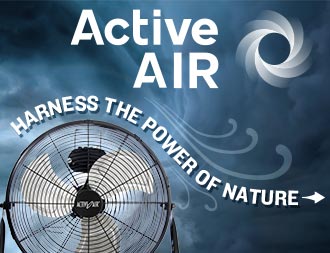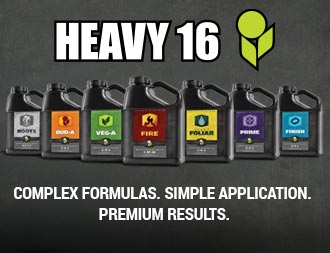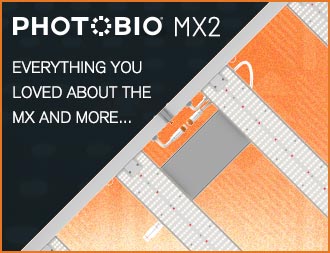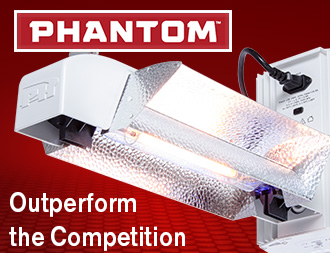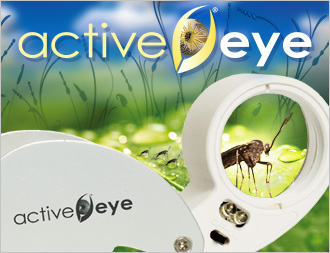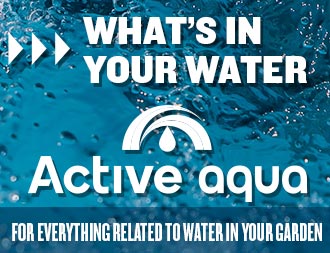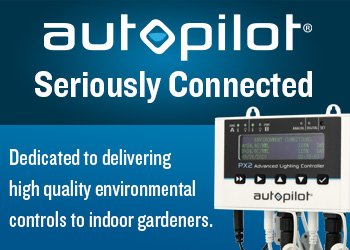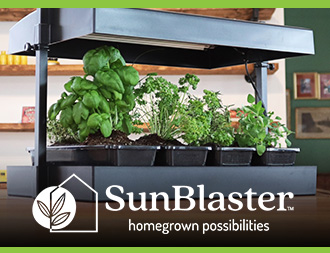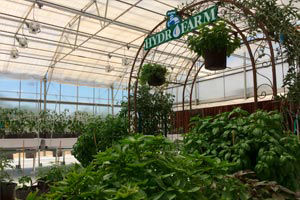Imagine a garden giving you gardenias in full bloom, a ripe plucked mango, or maybe you savor that fresh picked tomato flavor with pungent homegrown basil. This can be experienced any time of the year at any latitude, no matter how much snow, wind, or rain is coming down outside. Any plant grown under the sun can be grown in the "great indoors" with the use of HID (High Intensity Discharge) lighting.
HID lights can hang anywhere in the house, garage, or as a supplement to one's greenhouse. By choosing the right HID, a gardener can use a bulb with a particular band of light to induce greater flower and fruit yields than what can be produced under sunlight. Other HID bulbs encourage a more compact plant, promoting more green leafy growth. The sun has obvious advantages but when it's not available, or when specialized plant performance is desired, previously unimaginable gardening potential can be realized with the use of HID lights.
There are two common myths associated with HID lights: 1) They are too expensive and 2) They are mistakenly categorized with fluorescent grow lights. Look for fluorescent grow lights that are full spectrum. These lights are good for seedlings but high light requiring plants (any plant other than houseplants) require much more light. Seedlings left too long under fluorescents stay scrawny, grow very slowly and usually won't go on to produce fruit.
HIDs utilize a glass tube within an outer glass envelope. The inner glass tube contains a mixture of up to five different gases, through which electricity is channeled. The three major types of HIDs each have a different blend of gases, each on producing its own range of light color. HIDs are sold with either a ballast that is built into the reflector for the 175 and 250 watt sizes or they come pre-wired in their own separate metal box for the 400 and 1000 watt sizes. This box is referred to as the remote ballast. Be careful if buying used parts because each wattage ballast must match the wattage and type of the HID bulb.
To get more light for your money, shop for light systems with horizontally mounted bulbs. HID bulbs do not emit light from the end opposite the socket. Therefore, in vertically aligned systems, light must travel to the reflector first and then down to the plant. Horizontally mounted bulbs take a direct, shorter route and hence are brighter in both the center and the edges in the field of coverage. The 175 watt covers a 2' x 2' area. The 250 covers 3' x 3', 400 watts cover 5' x 5', and the 100 watts cover a 10' x 10' area. The field of coverage is considered 20 percent greater for seedlings or low light requiring plants or for all plants when used to supplement the sun in a greenhouse.
Reflector designs are very critical since half of the light is directed upwards. The best designs are those that use a double parabolic pattern where a ridge is directly above the bulb. These designs are used by companies such as Hydrofarm who make Super Grow Wing and Sunburst series light systems. The double arches used in these systems allow light to bounce out and around the bulb and down towards the plant. Light systems that have only a flat surface above the bulb reflect light back to the bulb blocking some of it from the plants and causing the bulb to run too hot and burn out prematurely.
Vent ports on the side end and top of reflectors allow for heat to escape. Cooling fans can be added to these ports on some systems. These fans mount on the reflector and channel heat out of the room during the summer. In the winter, heat from the bulb can be vented down below the plants for additional warmth.
Tempered glass shields, sometimes called lenses, are available for the better reflectors. Tempered glass keeps more of the damaging heat away from the plants, thus making it possible to lower the light source closer to the plants. Lenses are also an important safety feature. They block any moisture from ever reaching the bulb, which could cause the bulb to rupture.
Hydrofarm's light systems have recently come out with a specular finish insert for their reflectors. This textured surface breaks up the reflected light so there isn't any focused light or light streaks in some areas and less light in others. The new surface is also 25 to 40% more reflective that earlier designs. HID light systems are available in two basic types: metal halide, and high pressure sodium.
Metal Halide
Metal Halides produce an abundance of light in the blue spectrum. This color of light is excellent for green leafy growth and keeping plants compact. The average lifespan is about 10,000 cumulative hours. By this time the mixture of gases has become ineffective and the bulb should be replaced. The bulb will light up beyond this time but due to the gradual decline of light, it is not worth your while to wait for the bulb to finally burn out. They are very miserly in their use of power. Compare their lumen (brightness) per unit of energy consumed. Metal halides produce up to 125 lumens per watt compared to 39 lumens per watt with fluorescents and 18 lumens per watt for standard incandescent bulbs.
Recent developments in the metal halide family of bulbs include the daylight halide. This halide is color corrected. Objects that it illuminates appear as they would on a summer's afternoon. These lights are popular with those who want to show off their plants without any additional artificial-looking color cast upon them. Daylight halides are also used by people with terrariums and those who need objects illuminated to reveal their "true colors", such as quilters, photographers, painters and other artists. However, daylight halides are not as bright as the metal halide super bulb. Super metal halides have a noticeable but slight yellow cast to their light. They are 10% brighter than the original metal halide and require no extra electricity to operate. Of the halides, the super bulb is the best for aggressive growth.
Another new metal halide that came on the market in 1994 is the Agrosun Halide. This bulb has all the brightness of the super metal halide and the same lifespan. Its advantage is that it has a wider spectrum than the other metal halides. Its extra 38% more orange-red light will induce flowering sooner than the previous models.
High Pressure Sodiums
HPS bulbs have quite a noticeable difference in the color of light they emit. HPS bulbs emit primarily an orange-red glow. This band of light triggers hormones in plants to increase flower production. These colors also promote stem elongation. This elongation increases the number of internode spacings (the space between each leaf bud), thus further contributing to the number of flowering sites.
Not only is this a great flowering light, it has two features that make it a more economical choice. Their average lifespan is twice that of metal halides, but after 18,000 hours of commutative use, they will actually start to draw more electricity than their rated watts while gradually producing less light. HPS bulbs are very efficient. They produce up to 140 lumens per watt. Their disadvantage is they are deficient in the blue spectrum. If a gardener were to start a young plant under a HPS bulb, (s)he would see some impressive vertical growth. In fact, probably too impressive. Most plants would grow up thin and lanky and in no time you will have to prune your plant back before it grows into the light fixture. The exception to this is using an HPS in a greenhouse. Sunlight is high in the blue spectrum which would offset any stretching caused by HPS bulbs.
Many gardeners start out young plants with a metal halide system (systems include all the essentials: bulb, socket, reflector, cord and ballast) and as flowering begins, they remove the halide bulb and replace with an HPS conversion bulb. Conversion bulbs produce orange-red light but operate in a halide system. They are available in all sizes for the halide to HPS conversion. However, there is only one halide conversion bulb - the 400 watt halide conversion which operates in a 400 watt HPS system. It is important to remember never try mounting a halide bulb in a HPS system or vice versa. It is guaranteed to prematurely burn out the bulb.
Which Light is Best?
1. Indoors/non-greenhouse for predominately non-bloomers: the Agrosun halide systems.
2. Indoors/non-greenhouse for flowering and fruiting plants;
Start with a metal halide system and at the start of flowering, switch to an HPS conversion bulb. With rooms with limited vertical space this is an especially good path to take.
3. Greenhouse: HPS is considered best for greenhouses. With greenhouses, the day length can be extended by having the lights come on four hours prior to sunrise and four hours following sunset. During winter months there is anywhere from 25 to 35% less light reaching most parts of the United States. Also the cloud and fog cover can further decrease light and slow plant growth.
How To Get More Light For Your Dollar
Some utilities offer residents and businesses a choice of rate schedules which can add up to large savings each year. Off-peak rates lower after 6 p.m. and before 12 noon. Rates increase substantially between 12 p.m. and 6 p.m. to discourage use during these hours. Grow lights can be successfully run during the off peak hours at a noticeable savings.
Another rate schedule works on a seasonal basis. This benefits people who use less electricity in the summer and more in the winter. Winter is considered November through April. Many HID gardeners only use these lights in the darker colder months. This schedule does have a higher monthly meter fee but still may be worth your while. An additional drop in hourly rates is available for low income utility users.
A free computer rate analysis can be printed up to make the decision easier for you. Decide carefully, as you cannot reverse a schedule change for a full year from the date of the changeover.
Light Movers
Light movers can double even triple the coverage that the some stationary light could do with only a negligible increase in energy consumption. Mover motors draw only 10 watts or less. Light movers not only spread the light but the heat as well. This allows the light to skim over plants with out bleaching the upper leaves from constant direct brightness. Under a stationary light, the plant closest to the light grows the fastest because it receives the most energy. Eventually, the taller plant will shade those towards the perimeter and create a pattern of growth with a shape of a pyramid. Light movers change the position of the light source so plants receive light from different angles.
Mylar is strongly recommended for indoor growers. This is the most reflective material, it keeps usable light from being wasted by absorbing into the walls.
Hours of Light and Dark
There are general guidelines for plants and how they internally track time, or photoperiodism. Most vegetables can use up to 18 hours of light per day and flower more abundantly when the light is cut back to 12 hours on and 12 hours off. Plants that flower predominately in the spring or summer are long day plants. They need 16 hours of light or more to initiate flowering. Day neutral plants are activated by factors other than light such as temperature of a chronological time tracking. These plants can be illuminated 14 to 18 hours per day.
A Few Safety Tips
Keep remote ballasts elevated on a cinder block or shelf in case you end up with a lot of water on the floor. Do not use extension cords with the 250, 400 or 1000-watt light systems and be sure to use a three prong grounded timer. To protect your investment from power surges and spikes, use a surge suppressor. As is the case with sunlight, avoid looking into the bulb or you're sure to see stars. Make sure there is adequate air intake as plants will need fresh air. Exhaust fans both remove stale air and bring in fresh CO2-rich air. Young plants are more prone to heat damage from your light system. Keep lights at least three feet away and more for the larger lights. As plants get older they can handle the extra heat and the plant to light distance can be decreased. Ask your local dealer if their light system parts are UL listed electric components. Most also offer a full year warranty on the ballast and the bulb. Hydrofarm offers a 5-year warranty on their ballast and one year on the bulb.
Reprinted by permission.


